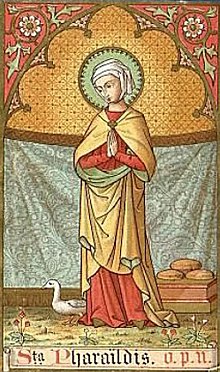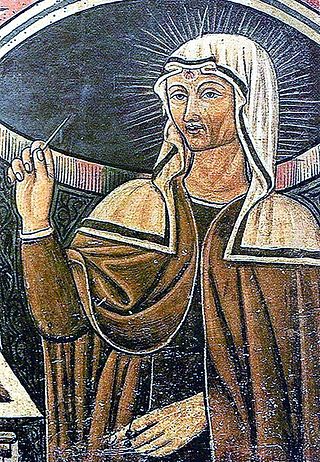
Rita of Cascia, OSA, was an Italian widow and Augustinian nun. After Rita's husband died, she joined a small community of nuns, who later became Augustinians, where she was known both for practicing mortification of the flesh and for the efficacy of her prayers. Various miracles are attributed to her intercession, and she is often portrayed with a bleeding wound on her forehead, which is understood to indicate a partial stigmata.

Gudula of Brabant, also known as Saint Gudula, was a Christian saint who is venerated in Catholic and Orthodox churches. In Brabant, she is usually called Goedele or Goule;. Her name is connected to several places: Moorsel, Brussels and Eibingen.

Radegund was a Thuringian princess and Frankish queen, who founded the Abbey of the Holy Cross at Poitiers. She is the patroness saint of several churches in France and England and of Jesus College, Cambridge.
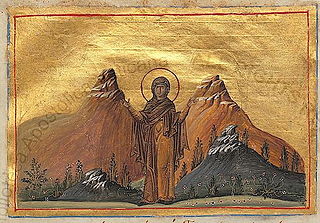
Thecla was a saint of the early Christian Church, and a reported follower of Paul the Apostle. The earliest record of her life comes from the ancient apocryphal Acts of Paul and Thecla.
Æthelburg was Queen of Wessex by marriage to King Ine of Wessex. Perhaps most famed for her act in 722, when she destroyed the stronghold of Taunton in an attempt to find the rebel Ealdbert.
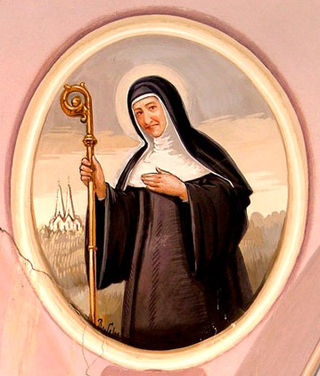
Mechtilde of Hackeborn, OSB, also known as Mechtilde of Helfta, was a Saxon Christian saint and a Benedictine nun. She was famous for her musical talents, gifted with a beautiful voice. At the age of 50, Mechtilde went through a grave spiritual crisis, as well as physical suffering. In the modern Benedictine calendar, her feast is celebrated on the anniversary of her death, November 19. She died in the convent of Helfta, near Eisleben.
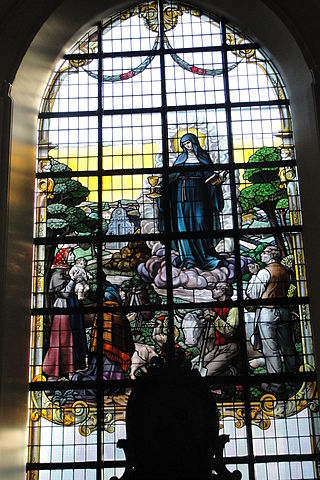
Berlinda was a Benedictine nun of noble descent. Her feast day is 3 February.
Æthelburhof Kent (born c. 601, sometimes spelled Æthelburg, Ethelburga, Æthelburga; Old English: Æþelburh, Æðelburh, Æðilburh, also known as Tate or Tata), was an early Anglo-Saxon queen consort of Northumbria, the second wife of King Edwin. As she was a Christian from Kent, their marriage triggered the initial phase of the conversion of the pagan north of England to Christianity.

Amalberga of Temse, was a consecrated virgin, and possibly an abbess. She is considered a saint. Raised by Saint Landrada, who founded Munsterbilsen Abbey, she refused Charlemagne's offer of marriage. Amalberga became a nun under Landrada and either succeeded her as abbess or governed a community of nuns on her own lands.
Henry, in German Heinrich, was the archbishop of Mainz from September 1142 until his deposition in June 1153.

The Diocese of Liège is a Latin Church ecclesiastical territory or diocese of the Catholic Church in Belgium. The diocese was erected in the 4th century and presently covers the same territory as Belgium's Liège Province, but it was historically much larger. Currently, the diocese is a suffragan in the ecclesiastical province of the Archdiocese of Mechelen-Brussels. Its cathedra is found within St. Paul's Cathedral in the episcopal see of Liège.
Kyneburga, Kyneswide and Tibba were female members of the royal family of Mercia in 7th-century England. They are venerated as saints.

Caritas Pirckheimer was Abbess of Saint Clara's convent in Nuremberg at the time of the Reformation, which she opposed due to the threat posed by Martin Luther to Catholic houses of worship and religious buildings, including her own convent.
St. Mother Irini was the Coptic Abbess of the St. Philopateer Mercurius’ Convent in Old Cairo, Egypt and an influential figure in the Coptic Christian community of Egypt.

Agnes II was a member of the House of Wettin who reigned as Princess-Abbess of Quedlinburg.
Baudonivia was a nun and hagiographer at the convent of Holy Cross of Poitiers. Very little is known about her. She wrote a biography of Radegund, Queen, founder of Holy Cross, and saint. Scholars have noticed a marked difference in perspective between an earlier life of Radegund composed by Venantius Fortunatus, written from a close friend's perspective, and Baudonivia's, written from the perspective of a nun of Radegund's own convent.

Saint Demiana and the 40 virgins was a Coptic martyr of the early fourth century.

The Abbey of the Holy Cross was a French Benedictine nunnery founded in the 6th century. Destroyed during the French Revolution, a new monastery with the same name was built in a nearby location during the 19th century for a community of Canonesses of St. Augustine of the Mercy of Jesus.
Lina Dorina Johanna Eckenstein was a British polymath and historian who was acknowledged as a philosopher and scholar in the women's movement.
Egburg was a 9th-century abbess about whom little is known. A letter by her remains in the Boniface correspondence, in which she writes to Saint Boniface of her grief. The letter evidences that she was highly learned—according to Eleanor Duckett, "Her letter is short, and her misery is very great; she manages, however, to bring in four reminiscences of Vergil's Aeneid, two of various writings of Aldhelm of Malmesbury ..., two of a letter written by Jerome to the monk Rufinus, together with at least half a dozen quotations from the Bible". Lina Eckenstein proposes she might have been a daughter of Ealdwulf, king of East Anglia, and the abbess of Repton.
